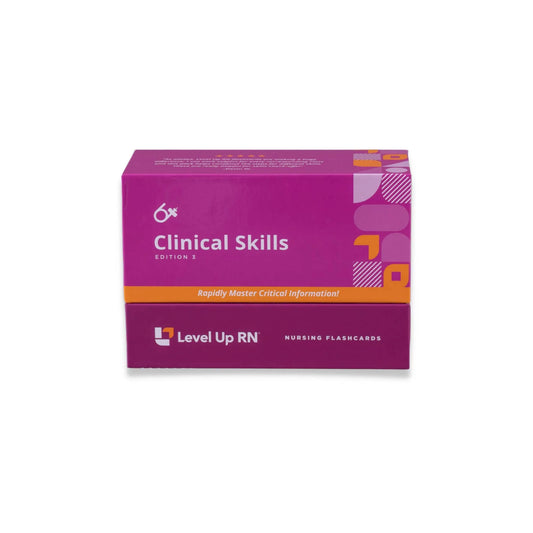Clinical Skills - IV Piggyback (Secondary)
A demonstration on how to set up an intravenous piggyback medication (secondary).
Full Transcript: Clinical Skills - IV Piggyback (Secondary)
Full Transcript: Clinical Skills - IV Piggyback (Secondary)
Hi. I'm Ellis with Level Up RN. In this video, I'll be demonstrating how to hang an IV piggyback or secondary line, as well as how to perform an IV push or bolus medication. I'll be following the steps that are on our clinical nursing skills cards. So if you've got this deck, grab these cards and you can follow along with me. If you don't have the deck and you're interested in getting one, head on over to LevelUpRn.com. A few quick tips before I get started with the demonstration. When I'm using a saline flush, I need to make sure that I eject the air. So I am going to go ahead and demonstrate that for you. So you've probably seen this in TV and movies, right? They always do this. I did a little bit extra that time. That's because there's air and it's pressurized. And so if I don't pop that before I use it on a patient, it not only has an air bubble in it, but it can be really difficult to get it started. So after I open a fresh saline flush, I need to go ahead and eject that air. The second thing I wanted to note is that if I'm using a saline lock, so if my patient doesn't have a continuous IV running, the clamp should be clamped when it's not in use. And so I have had students that approach the patient to administer a saline flush or an IV push medication, and they attach it to their patient's saline lock, and they're pushing and pushing and pushing and pushing and they're so confused why it won't go in. Well, it won't go in because their lock is engaged. So if there is no medication or fluids running through their IV, it should be locked, and it probably is locked. So make sure that the clamp is unclamped before you attempt to give that patient an IV push or a flush.
To prepare for administering a secondary or piggyback, I'm going to have washed my hands, and I've already got my gloves on. My patient already has a primary line set up, and I've already noted that it's compatible because it is normal saline. So that means that it's okay to run my secondary line. So I'm going to get my bag and take the stopper out. I'm going to pick up my secondary tubing and make sure that it is clamped, so that when I attach it to the bag, it doesn't immediately just run out. I'm going to take the cap off my spike end, and I'm going to carefully push and twist the spike into the port. I can now hang my secondary bag on my pump. I'm going to squeeze this drip chamber until it's about half full, and then I'm going to take the end cap off my secondary tubing.
Now, for this next step of priming the tube, I want to have good control over my roller clamp. If I just open up my roller clamp, this fluid will just wildly shoot out the end of the tubing, and I'm going to end up wasting whatever's in that bag and not know how much I've wasted. So I need to very carefully unroll this clamp slowly while I'm watching the drip chamber release the fluid so that once it starts to release, I have control over it so it doesn't do that, and I only waste a little bit of the medication.
Now, my pump's got one of those disinfectant protective caps on the port, but your facility may not use these. If you don't have a disinfectant cap, you'll just use a antiseptic swab to clean this port before you attach your secondary line. And then make sure you have unclamped your secondary line, otherwise, when your pump begins to pull, it will think there's an occlusion and it won't actually run. Make sure that when you attach the secondary line, you are using the port that is above or on the pump. I've seen many students attach their secondary line to this port because it's accessible, it's right in sight, and we use it for other things, but unfortunately, if you attach your secondary medication to this port and then open the clamp, it administers itself via gravity, and you have no control over the rate at which it's being administered. So you want to make sure that it is in fact going through the pump itself. Some of your pumps and tubing will require your primary line to be lower than your secondary line, and these will come with hooks and hangs to do that, or your pole will be equipped with that as well. So I may need to hang my primary line so that it makes my secondary line be the one the pump is pulling from because of gravity. And then all I need to do is set the rate on my pump, making sure that I'm administering this at the correct rate, and my patient will receive their secondary or piggyback medication.



1 comment
Very helpful, thank you.